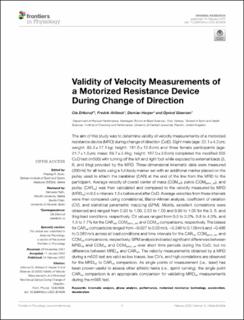Validity of velocity measurements of a motorized resistance device during change of direction
Peer reviewed, Journal article
Published version
Permanent lenke
https://hdl.handle.net/11250/3010156Utgivelsesdato
2022Metadata
Vis full innførselSamlinger
- Artikler / Articles [2119]
- Publikasjoner fra Cristin [1107]
Sammendrag
The aim of this study was to determine validity of velocity measurements of a motorized resistance device (MRD) during change of direction (CoD). Eight male (age: 22.1 ± 4.2 yrs; weight: 83.3 ± 17.1 kg; height: 181.6 ± 12.6 cm) and three female participants (age: 21.7 ± 1.5 yrs; mass: 69.7 ± 2.4 kg; height: 167.0 ± 3.6 cm) completed the modified 505 CoD test (m505) with turning off the left and right foot while exposed to external loads (3, 6, and 9 kg) provided by the MRD. Three-dimensional kinematic data were measured (200 Hz) for all tests using a full-body marker set with an additional marker placed on the pulley used to attach the carabiner (CAR) at the end of the line from the MRD to the participant. Average velocity of overall center of mass (COMvel), pelvis (COMpelvis_vel), and pulley (CARvel) was then calculated and compared to the velocity measured by MRD (MRDvel) in 0.5 s intervals 1.5 s before and after CoD. Average velocities from these intervals were then compared using correlational, Bland–Altman analysis, coefficient of variation (CV), and statistical parametric mapping (SPM). Mostly, excellent correlations were observed and ranged from 0.93 to 1.00, 0.53 to 1.00 and 0.93 to 1.00 for the 3, 6, and 9 kg load conditions, respectively. CV values ranged from 0.3 to 3.2%, 0.8 to 4.3%, and 1.5 to 7.7% for the CARvel, COMpelvis_vel, and COMvel comparisons, respectively. The biases for CARvel comparisons ranged from −0.027 to 0.05 m/s, −0.246 to 0.128 m/s and −0.486 to 0.082 m/s across all load conditions and time intervals for the CARvel, COMpelvis_vel, and COMvel comparisons, respectively. SPM analysis indicated significant differences between MRDvel and COMvel and COMpelvis_vel over short time periods during the CoD, but no difference between MRDvel and CARvel. The velocity measurements obtained by a MRD during a m505 test are valid as low biases, low CV’s, and high correlations are observed for the MRDvel to CARvel comparison. As single points of measurement (i.e., laser) has been proven useful to assess other athletic tasks (i.e., sprint running), the single point CARvel comparison is an appropriate comparison for validating MRDvel measurements during the m505 test.
Beskrivelse
This is an open-access article distributed under the terms of the Creative Commons Attribution License (CC BY). The use, distribution or reproduction in other forums is permitted, provided the original author(s) and the copyright owner(s) are credited and that the original publication in this journal is cited, in accordance with accepted academic practice. No use, distribution or reproduction is permitted which does not comply with these terms.
